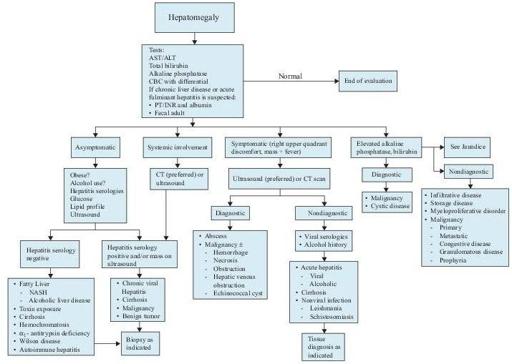Wallach's Interpretation of Diagnostic Tests: Pathways to Arriving at a Clinical Diagnosis (166 page)
Authors: Mary A. Williamson Mt(ascp) Phd,L. Michael Snyder Md

BOOK: Wallach's Interpretation of Diagnostic Tests: Pathways to Arriving at a Clinical Diagnosis
2.69Mb size Format: txt, pdf, ePub
Magnetic resonance imaging (MRI): Sensitivity is superior to CT scanning for mass lesions.
The advantages include lack of ionizing radiation and different planes of imaging.
• It is the technique of choice to look for hemangiomas.
• It is useful in distinguishing between a regenerating nodule and a tumor in the cirrhotic liver.
• MRI can be used to monitor the liver for iron and copper deposition and, with some modification, can identify fatty liver and can produce an estimated quantification of fat content.
• It can sometimes detect Budd-Chiari syndrome (hepatic vein thrombosis) without the need for IV iodinated contrast media (gadolinium is required).
The disadvantages include cost; slow time to acquire images, leading to more artifact; and limitations for patients with metal implants due to the use of a large magnet. MRI cannot distinguish a primary versus metastatic tumor.
Radioisotope scanning has been largely replaced by ultrasound and CT scanning.
Technetium-99m–labeled sulfur colloid scanning depends on uptake of phagocytic cells (Kupffer) and can help assess size and shape of the liver. Any disease where Kupffer cells are replaced by tumors, cysts, and abscesses produces a cold spot (adenomas); whereas with focal nodular hyperplasias, the liver will light up. Resolution for mass lesions is approximately 2 cm. Scintigraphy using radioactively labeled antibodies to tumor antigens is being developed as a diagnostic tool.
Gallium scanning uses gallium that is preferentially taken up in tissues synthesizing proteins (tumors or abscesses), and such areas show up as hot spots.
Imaging of the biliary tract
ERCP allows for therapy (e.g., stone removal or stenting) as well as diagnosis.
Percutaneous transhepatic cholangiography (PTC) allows for imaging of the proximal biliary ducts and some therapy (e.g., stent placement or percutaneous drainage) of the ducts.
More recently, magnetic resonance cholangiopancreatography (MRCP) has demonstrated diagnostic accuracy similar to ERCP. The principal disadvantages include spatial resolution, which may not be as good as that achieved with ERCP; lack of therapeutic benefit; and decreased ability to visualize the ampulla.

Figure5–6
Algorithm for the workup of hepatomegaly, if the vertical span is > 12 cm by physical examination or imaging. ALT, alanine aminotransferase; AST, aspartate aminotransferase; CBC, complete blood count; CT, computed tomography; FOBT, fecal occult blood test; GI, gastrointestinal; INR, international normalized ratio; NASH, nonalcoholic steatohepatitis; PT, prothrombin time.
Other books
Death Walker by Aimée & David Thurlo
Without Protection (Taking the Brat) by Kyra Keeley
Rough Diamonds: Wyoming Tough\Diamond in the Rough by Diana Palmer
The Mothers' Group by Fiona Higgins
The Power of Forgetting by Byster, Mike
Think Yourself Lucky by Ramsey Campbell
Mistress in the Making by Silver, Lynne
Socket 2 - The Training of Socket Greeny by Bertauski, Tony
Heal The Abuse - Recover Your Life by Jason Goodwin
Blacklight Blue by Peter May
